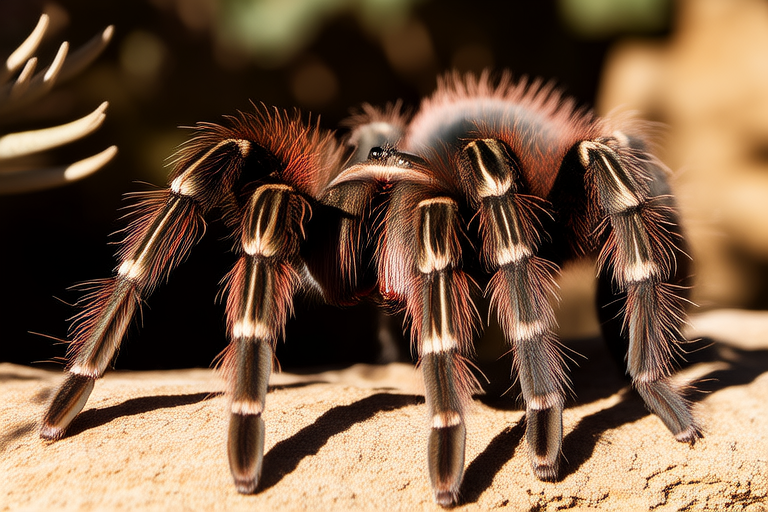The Ultimate Tarantula Experience: Tips and Tricks for Happy, Healthy Spiders
Welcome to the fascinating world of tarantulas! These magnificent creatures are captivating and can make wonderful pets when cared for properly. Whether you’re a beginner or an experienced owner, this guide will provide you with all the information you need to ensure your tarantula lives a long, happy, and healthy life.
Tarantula Species Overview
There are over 900 species of tarantulas, each with its own unique characteristics. Some species are more docile and easier to handle, while others are more skittish and less forgiving. Here’s a brief overview of some popular tarantula species:
- Bolivian Rose Tarantula (Grammostola rosea): Known for its beautiful pinkish-brown coloration and calm demeanor, making it a great choice for beginners.
- Chaco Golden Knee Tarantula (Grammostola pulchra): A stunning golden spider with a relatively docile temperament.
- Curly Hair Tarantula (Brachypelma albopilosum):
- Red Rump Tarantula (Brachypelma vagans): Another beginner-friendly species that is known for its striking red markings on the abdomen.
Before purchasing a tarantula, research the specific needs of the species you’re interested in to ensure you can provide the right care.
Essential Habitat Setup
Creating a suitable habitat is crucial for your tarantula’s well-being. The enclosure should mimic their natural environment as closely as possible, with attention paid to temperature, humidity, and substrate.
Temperature and Humidity
Most tarantulas thrive in temperatures between 75°F and 85°F (24°C to 29°C) and humidity levels ranging from 60% to 80%. Use a digital thermometer and hygrometer to monitor these conditions regularly. Heating pads and misters can help maintain the desired environment.
Substrate
Adequate substrate is essential for burrowing and hiding. Many owners use coconut fiber, cypress mulch, or peat moss. The substrate should be at least three inches deep, allowing the tarantula to dig and create a comfortable home.
Hiding Spots and Enrichment
Provide plenty of hiding spots such as cork bark, rocks, or small caves. These help reduce stress and offer security. Additionally, include branches or artificial plants for climbing and exploring. Regularly rotating these items keeps the enclosure interesting and enriches the spider’s environment.
Proper Feeding Techniques
Feeding your tarantula correctly is key to its health. Most tarantulas eat insects like crickets, roaches, and mealworms. Offer prey items that are smaller than the width of the spider’s abdomen to prevent injury.
Feed juveniles every 3-4 days and adults once a week. Remove any uneaten prey after 24 hours to avoid contamination. Dust food with calcium and vitamin supplements before feeding to ensure proper nutrition.
Handling and Interaction Tips
While tarantulas are generally docile, they can become stressed or defensive if mishandled. Always handle your tarantula gently and with care. Use a soft, wide-handled tool to scoop them up rather than picking them up by hand. Never grab or squeeze the spider.
Interaction should be kept to a minimum to prevent stress. If you wish to observe your tarantula, do so from outside the enclosure. Avoid sudden movements and loud noises that could startle the spider.
Common Health Issues
Like any pet, tarantulas can experience health problems. Here are some common issues and how to address them:
- Mites: These tiny parasites can cause distress. Keep the enclosure clean and free of debris. If mites are present, treat with a miticide recommended by a veterinarian specializing in exotic animals.
- Regurgitation: This can happen if the tarantula is too stressed or has eaten too much. Monitor the spider’s behavior and adjust feeding frequency accordingly.
- Leg loss: While leg loss is often a sign of molting, it can also indicate injury or illness. Consult a vet if you notice unusual behavior or physical changes.
Signs of a Healthy Tarantula
A healthy tarantula displays certain behaviors and physical characteristics:
- Active movement, especially during feeding times.
- Clear, shiny eyes.
- Healthy, full coloration.
- No signs of mites or other pests.
- Regular molting cycles.
Myths Debunked
Many misconceptions exist about tarantulas. Here are a few common ones:
- Myth: All tarantulas are aggressive and dangerous. Reality: Most species are docile and pose little threat to humans.
- Myth: Tarantulas require constant handling to stay active. Reality: Tarantulas are solitary creatures and prefer minimal interaction.
- Myth: Tarantulas don’t need hiding spots. Reality: Hiding spots are essential for reducing stress and providing security.
The Importance of Responsible Ownership
Owning a tarantula is a significant commitment. It’s important to research thoroughly before deciding to bring one into your home. Ensure you can provide the necessary care and environment for the spider’s entire lifespan, which can range from 10 to 20 years depending on the species.
Responsible ownership includes sourcing your tarantula ethically, from reputable breeders rather than wild-caught individuals. This helps preserve wild populations and ensures you receive a healthy, well-cared-for spider.
Conclusion
Caring for a tarantula can be a rewarding and educational experience. By following the tips and tricks outlined in this guide, you’ll be well on your way to providing a stress-free, enriching environment for your eight-legged friend. Remember, the key to successful tarantula ownership is patience, understanding, and a genuine love for these fascinating creatures.
